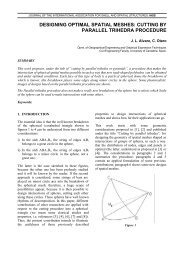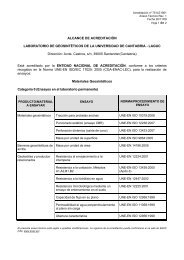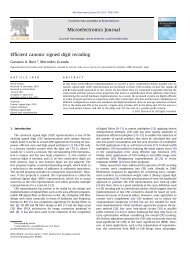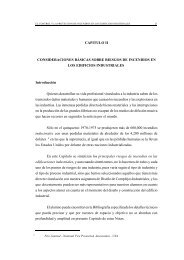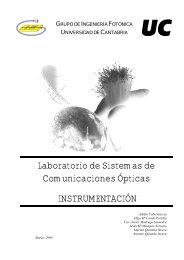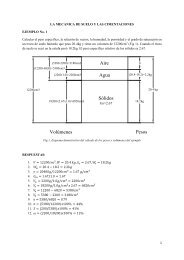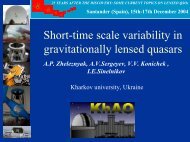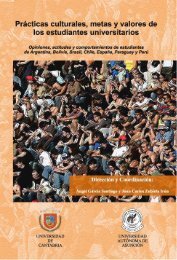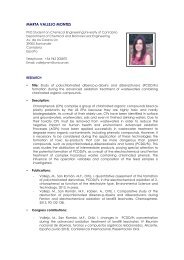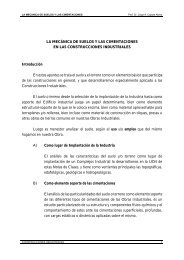XXXVII <str<strong>on</strong>g>IAHS</str<strong>on</strong>g><str<strong>on</strong>g>World</str<strong>on</strong>g> <str<strong>on</strong>g>C<strong>on</strong>gress</str<strong>on</strong>g> <strong>on</strong> <strong>Housing</strong>October 26 – 29, 2010, Santan<strong>de</strong>r, SpainCODE: 103PREDICTION OF THE MORTAR PROPERTIES RELATEDTO THE LIFE-CYCLE USING ULTRASONIC EVALUATIONJ. V. Fuente, T. Ibrahim, R. Fernán<strong>de</strong>z, V. Albert, V. CíscarDepartment of Applied Technologies for Structural Assessment and Heritage Evaluati<strong>on</strong>AIDICO, Instituto Tecnológico <strong>de</strong> la C<strong>on</strong>struccióne-mail: jvfuente@aidico.esKey words: ultras<strong>on</strong>ic testing, predicti<strong>on</strong> mo<strong>de</strong>ls, n<strong>on</strong><strong>de</strong>structive evaluati<strong>on</strong>, physical-chemicalanalysis, porosity, compressive strength.AbstractUltras<strong>on</strong>ic testing could be a powerful n<strong>on</strong><strong>de</strong>structive technique to extract some relevantinformati<strong>on</strong> about micro- and macrostructural performance of cement-based materials andstructures related to the curing and also <strong>de</strong>gradati<strong>on</strong> process. This paper presents theultras<strong>on</strong>ic inspecti<strong>on</strong>, c<strong>on</strong>si<strong>de</strong>ring the forward and backscattering energy could be used for thepredicti<strong>on</strong> of the microstructural c<strong>on</strong>crete properties as porosity and also mechanical strength.The experimental workplan takes the ultras<strong>on</strong>ic investigati<strong>on</strong> of some cement paste andmortars with two kinds of cements CEMI 42,5 R/SR and CEMII A-L 42,5 R. The w/c ratiohas been modified to provi<strong>de</strong> different porous nets.Ultras<strong>on</strong>ic grain noise shows the influence of the aggregates and large porosity while thevelocity is more affected by the ratio sand/cement phases. We have focused <strong>on</strong> how theseultras<strong>on</strong>ic parameters evolve according to the microstructural changes caused by the hydrati<strong>on</strong>process. The relevance of this research is to start up a n<strong>on</strong><strong>de</strong>structive evaluati<strong>on</strong> which canfollow the curing and <strong>de</strong>gradati<strong>on</strong> process through the changes caused in cement-based elasticmodules, increase of the porosity, and related to the mechanical behavior changes.Microstructural changes will be analysed by c<strong>on</strong>venti<strong>on</strong>al techniques as SEM, DRX andporosity Hg intrusi<strong>on</strong>. This work is framed in a general research that attempts to establish thepredicti<strong>on</strong> of final properties and <strong>de</strong>gradati<strong>on</strong> mo<strong>de</strong>l in sea water <strong>de</strong>gradati<strong>on</strong> of precastc<strong>on</strong>crete. But mortar is the sec<strong>on</strong>d step to un<strong>de</strong>rstand the variati<strong>on</strong> of our n<strong>on</strong><strong>de</strong>structiveparameters.37º <str<strong>on</strong>g>IAHS</str<strong>on</strong>g> <str<strong>on</strong>g>World</str<strong>on</strong>g> <str<strong>on</strong>g>C<strong>on</strong>gress</str<strong>on</strong>g> On <strong>Housing</strong> Science 59
XXXVII <str<strong>on</strong>g>IAHS</str<strong>on</strong>g><str<strong>on</strong>g>World</str<strong>on</strong>g> <str<strong>on</strong>g>C<strong>on</strong>gress</str<strong>on</strong>g> <strong>on</strong> <strong>Housing</strong>October 26 – 29, 2010, Santan<strong>de</strong>r, SpainCODE: 105CORK USAGE IN TRADITIONAL PORTUGUESEARCHITECTUREFerreira, R. F<strong>on</strong>tes; Silva, J. GuerreiroCdT Centro da Terra Associati<strong>on</strong> and University of Oporto, Portugale-mails: suberui@gmail.com; joanaguerreirosilva@gmail.comKey words: Cork, Portuguese Traditi<strong>on</strong>al Architecture, Local Materials.AbstractThe use of cork in Portuguese traditi<strong>on</strong>al architecture has been regularly menti<strong>on</strong>ed in worksbased <strong>on</strong> historical documents, but such documents are generically treated, with the subjectc<strong>on</strong>signed to the category of epiphenomena as something isolated, peculiar, localised or evenfortuitous. In the last <strong>de</strong>ca<strong>de</strong>, our research has <strong>de</strong>m<strong>on</strong>strated that cork is not an unknown andmarginal c<strong>on</strong>structi<strong>on</strong> material. If it were, how can <strong>on</strong>e justify its diachr<strong>on</strong>ic use in severalcork producing regi<strong>on</strong>s, associated to other types of c<strong>on</strong>structi<strong>on</strong> materials?As far as Portuguese traditi<strong>on</strong>al architecture is c<strong>on</strong>cerned, <strong>on</strong>e of the ol<strong>de</strong>st record we foundrefers to the applicati<strong>on</strong> of cork as coating in silos in the Islamic and medieval settlements; inadditi<strong>on</strong>, there are investigati<strong>on</strong>s that record the increasing employment of cork in traditi<strong>on</strong>alc<strong>on</strong>structi<strong>on</strong> in the middle Tagus and in the south of Portugal by the end of the Middle Ages.Furthermore, there are other key records, namely drawings from the beginning of the 16thcentury and a few written references, which reveal the applicati<strong>on</strong> of cork in houses in thenorth of Portugal. Within the c<strong>on</strong>text of traditi<strong>on</strong>al architecture, we also traced the usage ofcork in religious architecture, in particular in some m<strong>on</strong>asteries of the mendicant or<strong>de</strong>rsbecause those aimed to be similar to the poor buildings for comm<strong>on</strong> people, thus revealing thereality of c<strong>on</strong>structi<strong>on</strong> at that time.While studying the written or drawn registries and also the remaining c<strong>on</strong>structi<strong>on</strong>s, weanalyzed and interpreted the assembly systems. The set of case studies we gathered<strong>de</strong>m<strong>on</strong>strates the diversified number of applicati<strong>on</strong>s that cork has <strong>on</strong>ce had in buildings, aswell as reveals its recurrent utilizati<strong>on</strong> and expresses the maturity of these techniques.With this paper we aim to further examine these matters, encouraging a wi<strong>de</strong>r engineering andartistic investigati<strong>on</strong> in or<strong>de</strong>r to recover several ancient techniques as a basis for alternativeways of c<strong>on</strong>temporary c<strong>on</strong>structi<strong>on</strong>.37º <str<strong>on</strong>g>IAHS</str<strong>on</strong>g> <str<strong>on</strong>g>World</str<strong>on</strong>g> <str<strong>on</strong>g>C<strong>on</strong>gress</str<strong>on</strong>g> On <strong>Housing</strong> Science 60
- Page 1 and 2:
University ofCantabriawww.iahshousi
- Page 3 and 4:
ÍNDICE1. HONORARY COMMITTEE ______
- Page 5 and 6:
2. INTRODUCTIONThe International As
- Page 7:
4. ENTIDADES COLABORADORASColegio d
- Page 10 and 11:
6. ORGANIZING COMMITTEELOCAL ORGANI
- Page 12 and 13: 8. TOPICS - STATISTICSTOPIC I: MATE
- Page 14 and 15: also the Spanish aristocracy used t
- Page 16 and 17: 11. CONFERENCE ROOMSThe Con
- Page 18 and 19: Also, the Congress
- Page 20 and 21: 13. PLENARY SESSIONSPLENARY SESSION
- Page 22 and 23: October 26, 9 h 30-10 h 00 (Room 0)
- Page 24 and 25: October 26, 10 h 30-11 h 00 (Room 0
- Page 26 and 27: October 27, 9 h 30-10 h 00 (Room 0)
- Page 28 and 29: October 27, 10 h 30-11 h 00 (Room 0
- Page 30 and 31: October 28, 9 h 30-10 h 00 (Room 0)
- Page 32 and 33: October 28, 10 h 30-11 h 00 (Room 0
- Page 34 and 35: October 26, 201011 h 30-13 h 30 Cha
- Page 36 and 37: October 26, 201011 h 30-13 h 30 Cha
- Page 38 and 39: October 27, 201011 h 30-13 h 30 Cha
- Page 40 and 41: October 27, 201011 h 30-13 h 30 Cha
- Page 42 and 43: October 28, 201011 h 30-13 h 30 Cha
- Page 44 and 45: October 28, 201011 h 30-13 h 30 Cha
- Page 46 and 47: 16. TECHNICAL EXPOSITION (STANDS)37
- Page 48 and 49: TRIP A: MARITIME MUSEUM + PEDREÑA
- Page 50 and 51: RECEPTION COCKTAIL BY THE MAYOR OFS
- Page 52 and 53: 37º IAHS
- Page 54 and 55: GALA DINNERDía 28 de OctubrePassin
- Page 56 and 57: 37º IAHS
- Page 58 and 59: 19. ABSTRACTS OF THE CONGRESSABSTRA
- Page 60 and 61: XXXVII IAHS<strong
- Page 64 and 65: XXXVII IAHS<strong
- Page 66 and 67: XXXVII IAHS<strong
- Page 71 and 72: XXXVII IAHS<strong
- Page 73 and 74: XXXVII IAHS<strong
- Page 75 and 76: XXXVII IAHS<strong
- Page 77 and 78: XXXVII IAHS<strong
- Page 79 and 80: XXXVII IAHS<strong
- Page 81 and 82: XXXVII IAHS<strong
- Page 83 and 84: XXXVII IAHS<strong
- Page 85 and 86: XXXVII IAHS<strong
- Page 87 and 88: XXXVII IAHS<strong
- Page 89 and 90: XXXVII IAHS<strong
- Page 91 and 92: XXXVII IAHS<strong
- Page 93 and 94: XXXVII IAHS<strong
- Page 95 and 96: XXXVII IAHS<strong
- Page 97 and 98: XXXVII IAHS<strong
- Page 99 and 100: XXXVII IAHS<strong
- Page 101 and 102: XXXVII IAHS<strong
- Page 103 and 104: XXXVII IAHS<strong
- Page 105 and 106: XXXVII IAHS<strong
- Page 107 and 108: XXXVII IAHS<strong
- Page 109 and 110: XXXVII IAHS<strong
- Page 111 and 112: XXXVII IAHS<strong
- Page 113 and 114:
XXXVII IAHS<strong
- Page 115 and 116:
XXXVII IAHS<strong
- Page 117 and 118:
XXXVII IAHS<strong
- Page 119 and 120:
XXXVII IAHS<strong
- Page 121 and 122:
XXXVII IAHS<strong
- Page 123 and 124:
XXXVII IAHS<strong
- Page 125 and 126:
XXXVII IAHS<strong
- Page 127 and 128:
XXXVII IAHS<strong
- Page 129 and 130:
XXXVII IAHS<strong
- Page 131 and 132:
XXXVII IAHS<strong
- Page 133 and 134:
XXXVII IAHS<strong
- Page 135 and 136:
XXXVII IAHS<strong
- Page 137 and 138:
XXXVII IAHS<strong
- Page 139 and 140:
XXXVII IAHS<strong
- Page 141 and 142:
XXXVII IAHS<strong
- Page 143 and 144:
XXXVII IAHS<strong
- Page 145 and 146:
XXXVII IAHS<strong
- Page 147 and 148:
XXXVII IAHS<strong
- Page 149 and 150:
XXXVII IAHS<strong
- Page 151 and 152:
XXXVII IAHS<strong
- Page 153 and 154:
XXXVII IAHS<strong
- Page 155 and 156:
XXXVII IAHS<strong
- Page 157 and 158:
XXXVII IAHS<strong
- Page 159 and 160:
XXXVII IAHS<strong
- Page 161 and 162:
XXXVII IAHS<strong
- Page 163 and 164:
XXXVII IAHS<strong
- Page 165 and 166:
XXXVII IAHS<strong
- Page 167 and 168:
XXXVII IAHS<strong
- Page 169 and 170:
XXXVII IAHS<strong
- Page 171 and 172:
XXXVII IAHS<strong
- Page 173 and 174:
XXXVII IAHS<strong
- Page 175 and 176:
XXXVII IAHS<strong
- Page 177 and 178:
XXXVII IAHS<strong
- Page 179 and 180:
XXXVII IAHS<strong
- Page 181 and 182:
XXXVII IAHS<strong
- Page 183 and 184:
XXXVII IAHS<strong
- Page 185 and 186:
XXXVII IAHS<strong
- Page 187 and 188:
XXXVII IAHS<strong
- Page 189 and 190:
XXXVII IAHS<strong
- Page 191 and 192:
XXXVII IAHS<strong
- Page 193 and 194:
XXXVII IAHS<strong
- Page 195 and 196:
XXXVII IAHS<strong
- Page 197 and 198:
TOPIC IV - HEALTH, COMFORT AND SAFE
- Page 199 and 200:
XXXVII IAHS<strong
- Page 201 and 202:
XXXVII IAHS<strong
- Page 203 and 204:
XXXVII IAHS<strong
- Page 205 and 206:
XXXVII IAHS<strong
- Page 207 and 208:
XXXVII IAHS<strong
- Page 209 and 210:
XXXVII IAHS<strong
- Page 211 and 212:
XXXVII IAHS<strong
- Page 213 and 214:
XXXVII IAHS<strong
- Page 215 and 216:
XXXVII IAHS<strong
- Page 217 and 218:
XXXVII IAHS<strong
- Page 219 and 220:
XXXVII IAHS<strong
- Page 221 and 222:
XXXVII IAHS<strong
- Page 223 and 224:
XXXVII IAHS<strong
- Page 225 and 226:
XXXVII IAHS<strong
- Page 227 and 228:
XXXVII IAHS<strong
- Page 229 and 230:
XXXVII IAHS<strong
- Page 231 and 232:
XXXVII IAHS<strong
- Page 233 and 234:
XXXVII IAHS<strong
- Page 235 and 236:
TOPIC VI - URBAN AND CITY PLANNING.
- Page 237 and 238:
XXXVII IAHS<strong
- Page 239 and 240:
XXXVII IAHS<strong
- Page 241 and 242:
XXXVII IAHS<strong
- Page 243 and 244:
XXXVII IAHS<strong
- Page 245 and 246:
XXXVII IAHS<strong
- Page 247 and 248:
XXXVII IAHS<strong
- Page 249 and 250:
XXXVII IAHS<strong
- Page 251 and 252:
XXXVII IAHS<strong
- Page 253 and 254:
XXXVII IAHS<strong
- Page 255 and 256:
XXXVII IAHS<strong
- Page 257 and 258:
XXXVII IAHS<strong
- Page 259 and 260:
XXXVII IAHS<strong
- Page 261 and 262:
XXXVII IAHS<strong
- Page 263 and 264:
XXXVII IAHS<strong
- Page 265 and 266:
TOPIC VII - ECONOMY AND FINANCING P
- Page 267 and 268:
XXXVII IAHS<strong
- Page 269 and 270:
XXXVII IAHS<strong
- Page 271 and 272:
XXXVII IAHS<strong
- Page 273 and 274:
TOPIC VIII - MANAGEMENT SCHEMES AND
- Page 275 and 276:
XXXVII IAHS<strong
- Page 277 and 278:
XXXVII IAHS<strong
- Page 279 and 280:
XXXVII IAHS<strong
- Page 281 and 282:
XXXVII IAHS<strong
- Page 283 and 284:
XXXVII IAHS<strong
- Page 285 and 286:
XXXVII IAHS<strong
- Page 287 and 288:
XXXVII IAHS<strong
- Page 289 and 290:
XXXVII IAHS<strong
- Page 291 and 292:
XXXVII IAHS<strong
- Page 293 and 294:
XXXVII IAHS<strong
- Page 295 and 296:
XXXVII IAHS<strong
- Page 297 and 298:
XXXVII IAHS<strong
- Page 299 and 300:
XXXVII IAHS<strong
- Page 301 and 302:
XXXVII IAHS<strong
- Page 303 and 304:
XXXVII IAHS<strong
- Page 305 and 306:
XXXVII IAHS<strong
- Page 307 and 308:
XXXVII IAHS<strong
- Page 309 and 310:
XXXVII IAHS<strong
- Page 311 and 312:
XXXVII IAHS<strong
- Page 313 and 314:
XXXVII IAHS<strong
- Page 315 and 316:
XXXVII IAHS<strong
- Page 317 and 318:
XXXVII IAHS<strong
- Page 319 and 320:
XXXVII IAHS<strong
- Page 321 and 322:
XXXVII IAHS<strong
- Page 323 and 324:
XXXVII IAHS<strong
- Page 325 and 326:
XXXVII IAHS<strong
- Page 327 and 328:
XXXVII IAHS<strong
- Page 329 and 330:
XXXVII IAHS<strong
- Page 331 and 332:
XXXVII IAHS<strong
- Page 333 and 334:
XXXVII IAHS<strong
- Page 335 and 336:
XXXVII IAHS<strong
- Page 337 and 338:
XXXVII IAHS<strong
- Page 339 and 340:
XXXVII IAHS<strong
- Page 341 and 342:
XXXVII IAHS<strong
- Page 343 and 344:
XXXVII IAHS<strong
- Page 345 and 346:
XXXVII IAHS<strong
- Page 347 and 348:
XXXVII IAHS<strong
- Page 349 and 350:
XXXVII IAHS<strong
- Page 351 and 352:
XXXVII IAHS<strong
- Page 353 and 354:
XXXVII IAHS<strong
- Page 355 and 356:
XXXVII IAHS<strong
- Page 357 and 358:
XXXVII IAHS<strong
- Page 359 and 360:
XXXVII IAHS<strong
- Page 361 and 362:
XXXVII IAHS<strong
- Page 363 and 364:
XXXVII IAHS<strong
- Page 365 and 366:
XXXVII IAHS<strong
- Page 367 and 368:
XXXVII IAHS<strong
- Page 369 and 370:
XXXVII IAHS<strong
- Page 371 and 372:
XXXVII IAHS<strong
- Page 373 and 374:
XXXVII IAHS<strong
- Page 375 and 376:
XXXVII IAHS<strong
- Page 377 and 378:
XXXVII IAHS<strong



